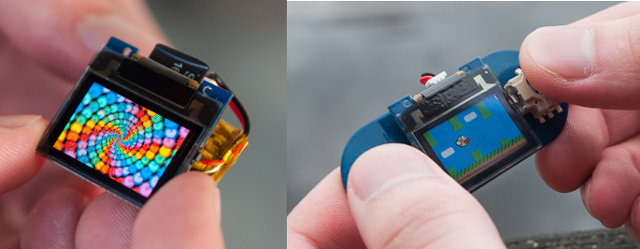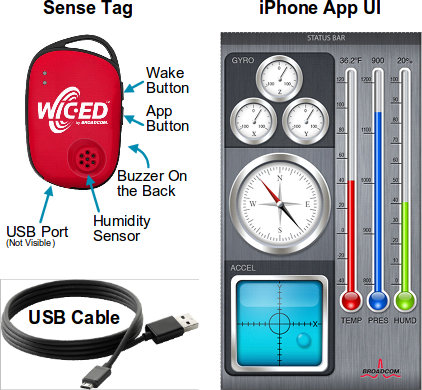Back in 2012, Tiny Circuits launched a Kickstarter campaign for TinyDuino, an Arduino compatible board that’s… tiny, based on Atmel Atmega328P, and supports tiny stackable shields in a similar fashion to Microduino (launched in 2013). The campaign was successful, and the company is now back on Kickstarter with TinyScreen, an OLED display that can be stacked on top of TinyDuino to create a smartwatch, a minuscule gamepad, smart glasses, and more. TinyScreen technical specifications: 96×64 OLED display, 16-bit color depth 0.96″ (24.4mm) viewable area Software controllable backlight (OLED brightness) Power down mode Four push buttons along the sides (connected to IO pins) SPI interface for display Power Supply – 3.0V to 5.5V operation (higher voltages supported with TinyShield power regulator) Power Consumption – 20 – 45mA max supply current (depending on brightness) Dimensions – 25.8mm x 25.0mm Programming of TinyDuino can be done through a web interface for Arduino called […]
KDDI Unveils Tiny BLE/Zigbee Development Board Running Mozilla Firefox OS
KDDI has recently announced Open Web Board, an HDMI TV stick powered by Rockchip RK3066, and running Firefox OS, just like the recently announced MatchStick. The board is however aimed at embedded and web developers who want to create apps for Firefox OS, and interface with external devices over Bluetooth Low Energy or Zigbee (optional module) communication, optionally using Gluin, a web based graphical “application development tool that enables simple linking programming between electronic devices”. Open Web Board specifications: SoC – Rockchip RK3066 dual core Cortex A9 processor @ 1.6 Ghz with Mali-400 MP4 GPU System Memory – 1 GB RAM Storage – 8 GB flash Video Output – HDMI USB – 1x USB 2.0 host port, 1x micro USB for power Connectivity – 802.11 b/g/n Wi-Fi (AP6210 module), Bluetooth 2.1 (HFP/A2DP/AVRCP)/4.0 GATT. and optional Zigbee via external module Dimensions – Small This dongle runs Firefox OS 1.4. KDDI showcased […]
Broadcom Introduces WICED Sense Bluetooth Low Energy Development Kit
Broadcom has recently announced a new development board for IoT applications using Bluetooth Low Energy (BLE) called WICED Sense. The kit consists of a “sense tag” powered by the company’s BCM20737S Bluetooth SIP Module with five micro-electromechanical sensors (MEMS), and Bluetooth 4.1 compatible WICED SMART software stack. The key features of WICED Sense devkit are as follows: Broadcom BCM20737 Bluetooth Smart system in package (SiP) module Five low-power MEMS sensors by ST Micro (part of the module): Gyroscope (L3GD20) Accelerometer (LIS3DSH) eCompass (LSM303D) Pressure sensor (LPS25H) Humidity Temperature sensor (HTS221) Bluetooth Smart connection covers distance of roughly 30 meters. USB – 1x micro USB connector to update applications Encryption, decryption, certificate signing, verification and various algorithms for increased privacy Secure Over-the-air (OTA) download capability to enable firmware updates from central device including smartphone, tablet and computers Misc – iBeacon, NFC, Wireless charging (Rezence A4WP) support. Power – Coin-cell battery The […]
Embedded Linux Conference Europe 2014 Schedule – IoT, ARM vs x86, Optimization, Power Management, Debugging…
The Embedded Linux Conference Europe (ELC 2014), CloudOpen, and LinuxCon Europe will jointly take place at the Congress Centre Düsseldorf, in Germany on October 13 – 15, 2014. The 3-day events will consists of keynotes, presentations, and tutorials. Each day will open with two or three keynotes by speakers including Jim Zemlin (Executive Director, Linux Foundation), and Jono Bacon (XPRIZE), followed by presentation and tutorials. There will be 45 presentations for ELCE, 58 for LinuxCon, and 47 for CloudOpen, I’ll make a virtual schedule with a few sessions part of the Embedded Linux Conference Europe “track”. Monday, October 13 11:15 – 12:05 – Performance Analysis Using the Perf Suite by Mans Rullgar, Consultant When faced with a performance problem, the initial steps towards a solution include identifying the sections of code responsible and the precise reasons they are time-consuming. To this end, the ‘perf’ profiling tools provide valuable insight into the […]





